Whether you are a beginner, intermediate, or advanced tennis player, an ideal player keeps his/her feet, thigs, arms, triceps, shoulders, glutes, and quadriceps in perfect condition which is possible when you make or follow proper tennis drills strategy.
Not only physically, but drills are also important to make you strong mentally so you can develop proper technique, and build confidence whether you are performing volleys, groundstrokes, serves, or slices, etc.
Moreover, tennis drills help beginner players learn and understand tennis fundamentals.
However, if you are starting as a newbie and have the dream to become an advanced player but with the mindset of just hitting a few balls a week and then resting in the bed, you are in the wrong game.
Tennis is one of those games that require the players to continuously keep moving forward, backward, left, and right. It requires your every muscle group in perfect working condition. It doesn't stop here, instead, it also wants you to be mentally strong as well.
For example, if you are playing a fast-paced doubles match and your opponent is nearly defeating you. This is where you need to be sharp rather than aggressive to think quickly and build a working doubles strategy right on the court during the game.
What I am trying to say is tennis is beyond just smashing the balls. Now you must be thinking, what should I do to make myself mentally and physically fit for tennis?
The answer is a proper tennis drills strategy! Practicing alone is a part of it which I have covered in detail in a separate article, do read it: How To Practice Tennis Alone.
Now that we have built enough base, let's move into details and explore the tennis drills that must be part of your practicing routine.
Before we move further, let me answer an important question, which is:
Why are tennis drills important?
Generally, we all know that exercises make our muscles strong, but is it enough to know?
Of course, not!
For example, you must have a strong grip over your eye-hand coordination which most of the trainers don't mention when discussing tennis drills. Another example is timing, which is obviously important lol, but it matters a lot on the tennis court.
Watching tennis pros playing a match looks so amazing and smooth, but there is a lot of hard work that those players do before reaching the court.
For example, the top tennis player Roger Federer spends 36 hours weekly doing workouts (12 hours in the gym).
So, let's first know the benefits of the drills that I am going to discuss in detail shortly.
Muscles Strength
Without saying, exercises improve muscle strength. But here with tennis drills, we are actually creating muscle memory.
I mean we will train our muscles through different drills enough that it becomes a memory for our muscles. So, when you try to perform forehand or backhand on the court, you must be able to hit without thinking.
In other words, you should be able to hit your desired stroke even with closed eyes, which is an ideal case, but we aim to reach this level.
It's possible only when we keep training our muscles even if they are trained enough. Not only it makes your muscles strong, but it also improves your thinking ability and makes you mentally strong as well.
Improves Timing on Court
When I say timing is important in tennis, I am not saying that you stay longer on the court. What I mean is the time to quickly react to every stroke. Bad timing means the pressure and strain on your wrist, arm, and shoulder that may lead to arm injuries like tennis elbow.
So we will be working to improve reaction time through various drills.
Coordination Improvement
Most importantly, we will be focusing on hand-eye coordination. Hand-eye coordination means your hands should follow the direction where your eyes see.
Generally, this works fine in normal conditions, but when you are playing at a fast speed match, this coordination needs to be perfect to hit precise strokes on time. This is possible when you follow tennis drills to improve this coordination.
Not only hand-eye coordination is key, but we will also be focusing on upper body movement, footwork, and balance to improve overall body coordination.
Now finally we are ready to move to the topic that you are looking for which is:
Tennis Drills
The major purpose behind any drill is to strategize, and improve your skills further so you can move quickly and perform the desired action/stroke perfectly.
For example, when to balance the body weight, when to move overhead, and when to slow down the pace to handle a fast match, etc.
Before doing any drill, remember, the first and foremost thing is the warmup.
But some of the drills require you to be at the court. I always prefer to practice on the court because being social is also a good thing.
WarmupHere I mean a warmup of 3-5 minutes rather than a few seconds. Skipping warm-up means your muscles are prone to strain and other injuries.
Warmup eases your muscles and makes them ready for the proper workout, and improves blood flow.
Being a tennis coach and an experienced player, I would recommend the tennis coaches not to let their students hit any ball until they have done enough warmup.
Few exercises you can perform as a warmup are:
Now finally, let's move to the tennis drills.
Some of the drills may require a racket, tennis ball while some drills don't require either of them.
How is each of my tennis drills organized?Under each drill, I have discussed the drill in general, how to perform step by step, and the benefits.
All of the drills are full of fun and entertainment, so our learning is going to be full of fun.
Tennis Warm-up Drills
Through these tennis drills, we will be doing dynamic warmup and flexibility exercises. The dynamic warmup is getting popular among many other sports, especially in modern tennis games.
Following are the reasons.
Here are some of the useful tennis drills for warm-up.
Jogging with Arm Circles
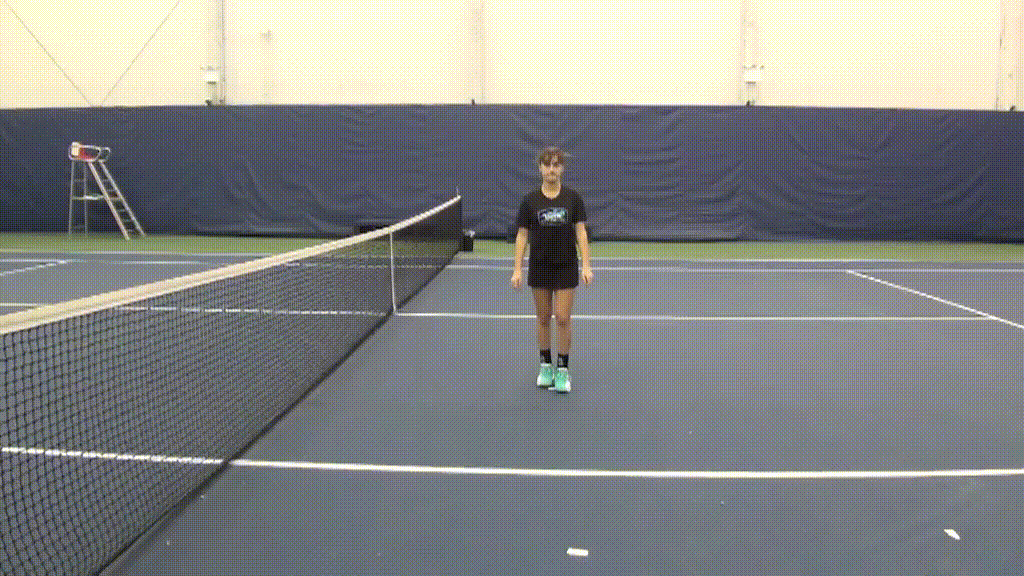
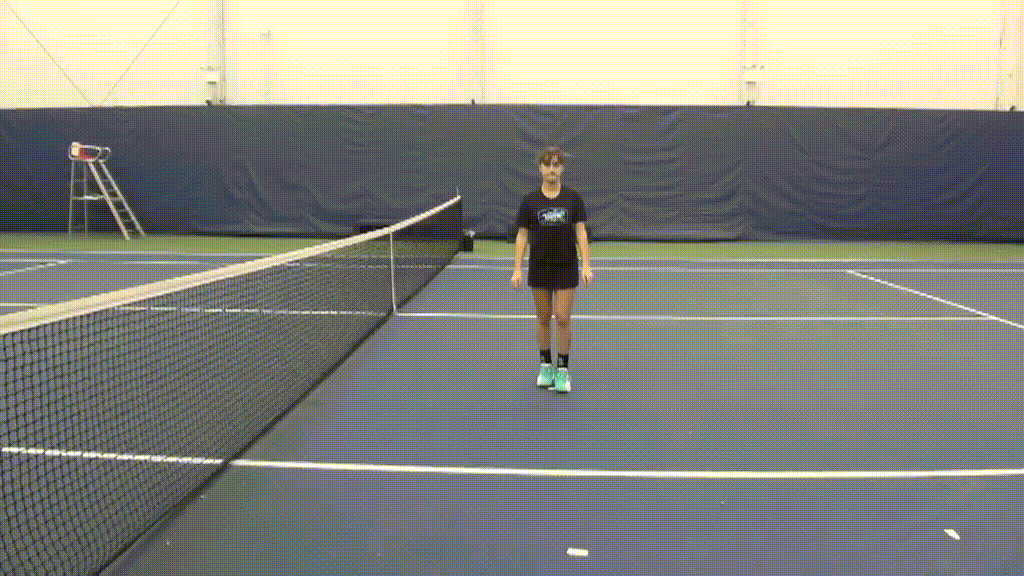
This is one of the best tennis warm-up drills that I do in my morning exercises. This is how you can do it.
Knees to Chest Stretch
This is more like a stretching drill but a good warmup exercise as well.
- Stand straight with your shoulders wide. Make sure your feet are hip-width apart.
- Maintain your back in a normal posture, neither too straight nor too bend, just natural position.
- Your arms should be straight by your sides.
- Before moving, move your right knees as high as you can and balance your body weight on the left foot.
- Grab your raised knee with both hands and push it towards your chest with greater force and press as firmly as you can. Don't bend your back when pushing the knee against your chest.
- Now release the knee and let it move back to the original position with your right foot on the ground.
- Now do the same with the left knee.
- Once done with both knees, take a step and move forward.
- Repeat the same with both knees again.
High Step Trunk Rotation
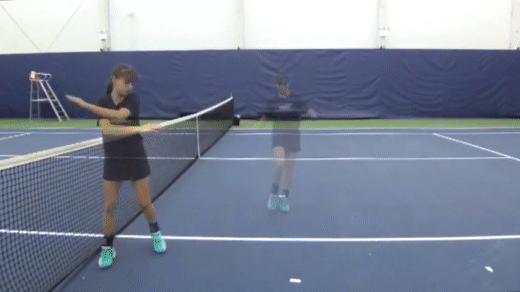
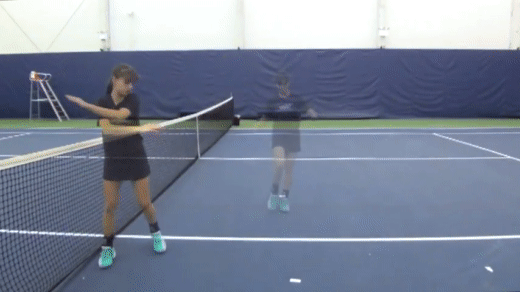
Inchworms
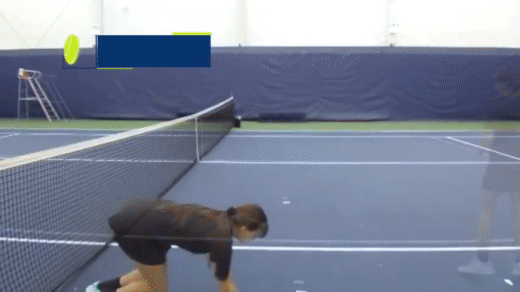
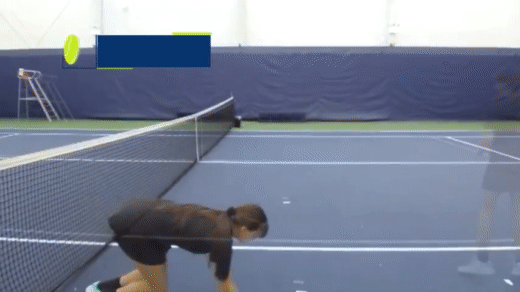
- Stand straight with your feet hip-width apart and shoulders wide.
- Bend down and reach your hands to your feet and place them on the ground.
- Now walk your hands in a forwarding direction until you reach the plank position.
- Walk your feet towards your hands without moving hands.
- Reach your feet as close to your hands as you can so that your hip is as high as it can be. Keep your knees straight.
- Stay in this position for 2-3 seconds.
- Again, walk your hands in the forwarding direction and reach the plank position.
- Do the same with your feet and reach the inchworm position again.
- Keep doing this until you reach your marked area on the court.
Tennis Fitness Drills
Upper & Lower Body Exercises
Upper body warmup and exercises are very important for any tennis player to prevent possible injuries. It prepares your arm, shoulder, wrist, and elbow for what is going to happen on the court.
There are plenty of upper body exercises but I am going to mention only that work for me the best.
Big Arm Circles
This is a very basic exercise that even your kid can perform easily. But, at the same time, it's a very effective drill to keep the blood flowing properly through your arm, shoulder, wrists, and hands.
Another benefit of big arms circles is that it is effective to release shoulder pain as well.
Muscles Involved:
Chest, shoulders, and upper back.
Skill Level: All
Trunk Rotation
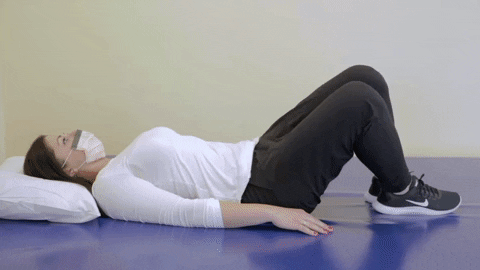
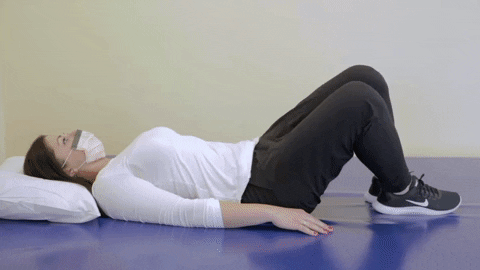
This is one of the shortest tennis drills to make your truck muscles strong. It also improves blood flow and prevents lower back injuries during the play while making the trunk more functional.
Moreover, it improves core strength and posture as well.
This exercise is performed while either standing or sitting. It can also be performed lying down on the ground.
Muscles Involved: Truck muscles and abs.
Skill Level: All
Back Stretch Using Foam Roller
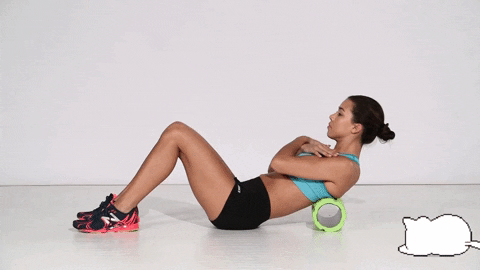
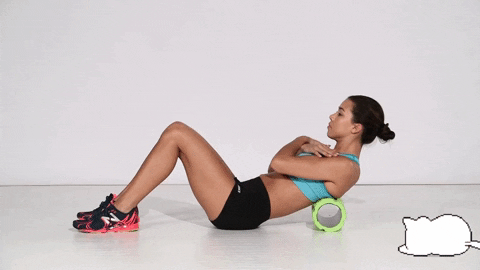
This fitness drill stretches your back and makes your spine strong and flexible.
Muscles Involved: Back muscles
Skill Level: All
Stretching Resistance Band
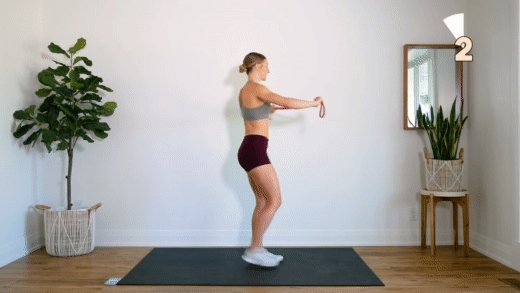
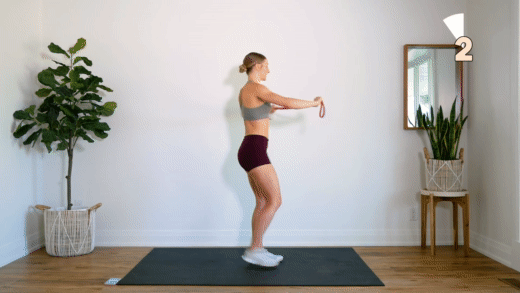
This exercise aims to improve blood pressure and flexibility of upper body muscles to prevent any injuries. Moreover, it strengthens your arms, shoulders, and wrists.
Muscles Involved: Arms, shoulders, wrists, upper back
Skill Level: All
High Knee Skips
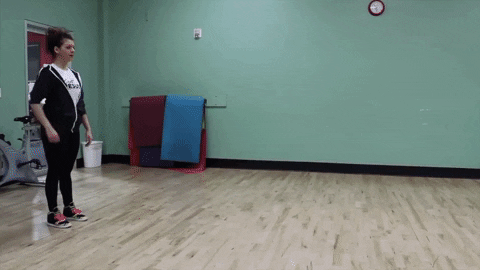
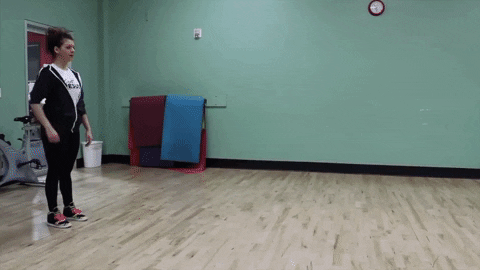
The sole purpose of this exercise is to get the blood flowing.
Note: While doing exaggerated jumps, maintain a rhythm so your jumps are identical.
Skill Level: All
Frankenstein Walk
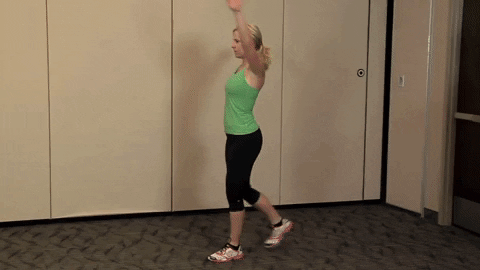
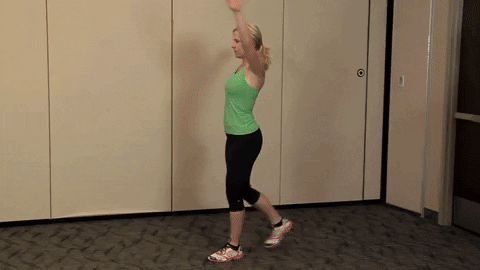
This exercise makes your hamstrings strong. Plus, it loosens your hips and calves muscles.
Muscles Involved:
Hips, calves, hamstrings
Skill Level: All
Tennis Footwork Drills
Although you will be hitting the ball using a racket by holding it in your hands, being strong on your feet is also very important.
Have you ever focused on Roger Federer's feet when he plays on the court? How smoothly he moves his feet? This should be your target.
However, reaching that level takes a lot of time and consistent training. With our footwork drills, you will be able to improve to a greater extent in less time.
Have you ever wondered, why beginner players miss most of the shots? It's because they are not fast at their feet.
No matter what level you play, footwork is a critical part of tennis and it should be done in the right way. Let me show you how we do it.
Running Lines
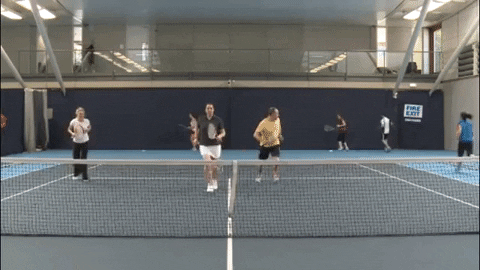
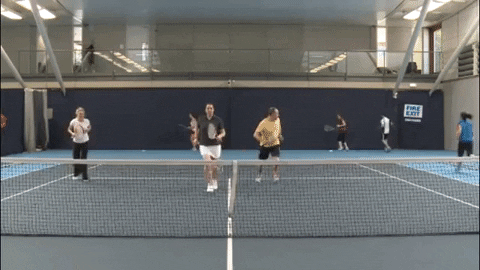
This fun running drill focuses not only on footwork but also overall body. As the name suggests, you will be running along the court lines.
There are different patterns to run the lines but the most common, which I teach my students, is the following.
Include this line drill in your tennis exercises and see the great improvement in your speed and footwork. This exercise can also be used as a warmup before starting a tennis match.
To make this drill more fun, add your partner and set a goal for who finishes it first.
Skill Level: All
Z-Ball
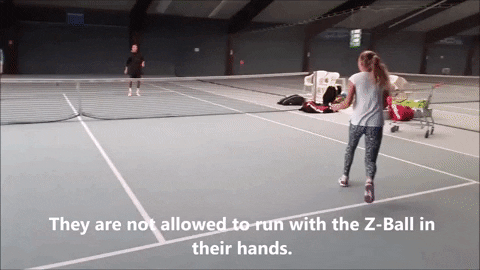
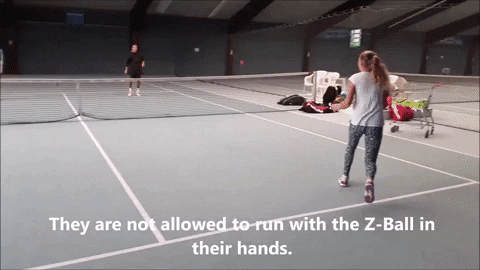
This drill is full of fun yet effective to improve agility, speed, and reaction time on the tennis court. This exercise requires two players.
You can use only service boxes for this drill. Consider this a mini tennis match but without a racket or tennis ball. We are using a z-ball or reaction ball for this drill.
You can make it more challenging by adding two more players. Now you will be playing a doubles match.
Skill Level: All
Spider Run
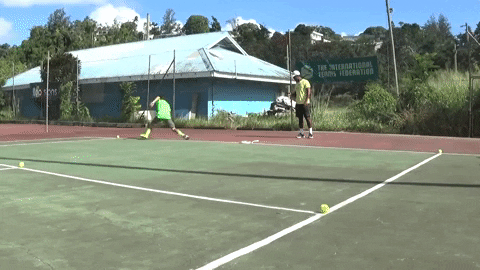
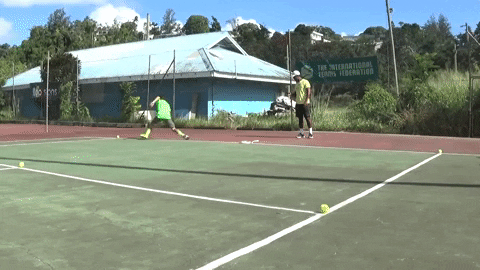
This is one of the best tennis drills to improve footwork and speed. In this drill, the movement pattern is more like the pattern we follow in a tennis match. So, this reason makes it important for all levels.
Before starting this drill, take 5 tennis balls and place them on the intersecting points on the court lines as demonstrated in the below picture.
You can change the movement pattern by changing the order of your movement. But I suggest the above-mentioned pattern as this is closely related to the actual movement on the court.
Skill Level: All
Back Step
This is one of the best tennis speed drills that strengthen your leg muscles as well.
Note: You have to stay on your feet' balls.
Tennis Ladder Drills
In tennis, the most important steps are small steps because with small steps you learn how to balance your body in response to the opponent's shot.
When you have mastered small steps, learning how to dominate the tennis court becomes easy, which I will be covering later in this article.
The best way to improve small steps is ladder drills. Another benefit of ladder drills is it improves stamina and coordination.
You can perform different ladder drills with the same agility ladder like one step, fast feet, shuffle feet, sidestep, etc.
First, we train our nervous system through visual data to create movement patterns in our minds. In the second stage, we use that data to improve this movement pattern further.
In other words, we make these movement patterns a habit in the second stage so that your mind doesn't have to process the data each time.
Here are some useful ladder drills.
Single Foot
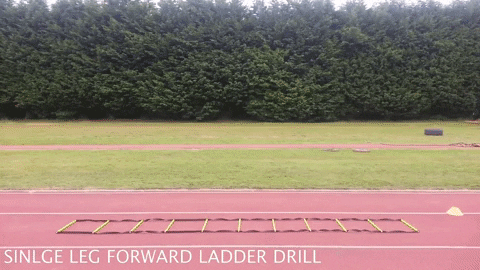
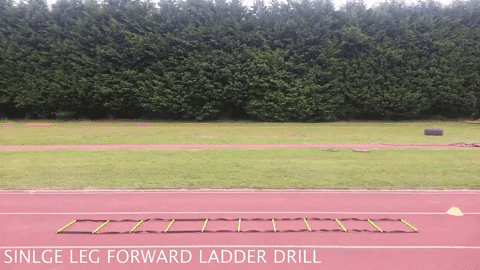
This is one of the most basic tennis drills that each tennis student learns in the first phase of training. In this drill, all you have to do is to jog or run at a slow speed while keeping one foot in one square at a time.
Do this until you reach the full length of the ladder.
Another effective version of this ladder drill is high knees, where you have to take high knees jumps while jogging in squares.
Skill Level: All
Two Feet
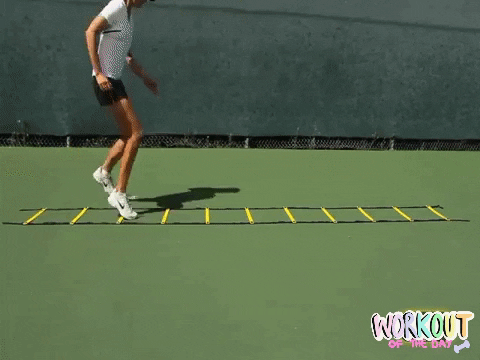
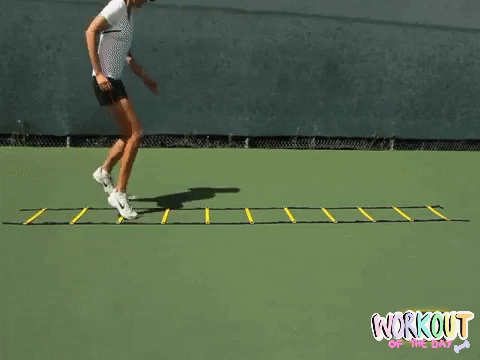
Unlike single feet, in this footwork, you have to put both feet in a single square each time before moving to the next step.
Remember, here you have to stay on the balls of your feet without touching your heels with the ground.
You can make it more challenging by adding high knees to this drill.
Skill Level: All
Lateral Steps or Split Steps
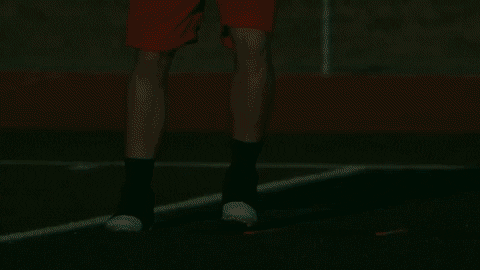

In this drill, you have to stand lateral to the ladder and move in the same stance. You can either move to the left or right depending on the ladder end you are standing at.
You can either use a single step or two feet like I mentioned above. Make it more challenging by adding high knees.
Skill Level: All
Jumping Jacks
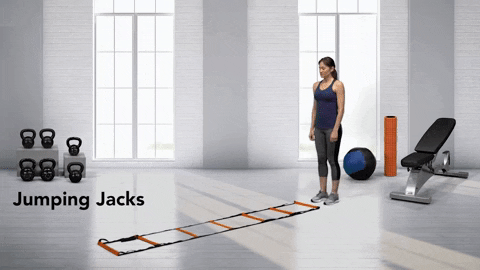
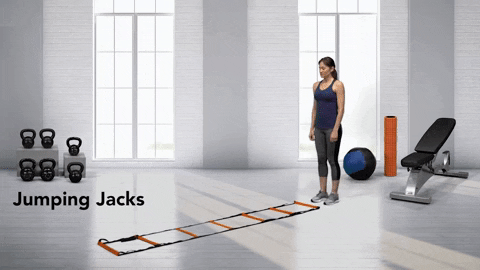
You must have seen this exercise at the gym. The only difference is that here you are using the agility ladder and moving forward until you reach the end of the ladder.
Skill Level: All
Double In Double Out
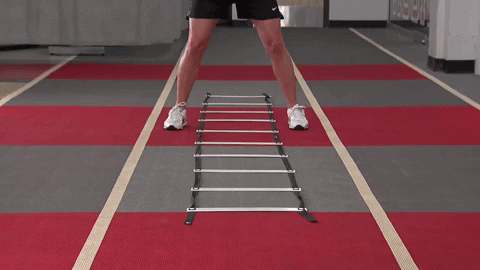
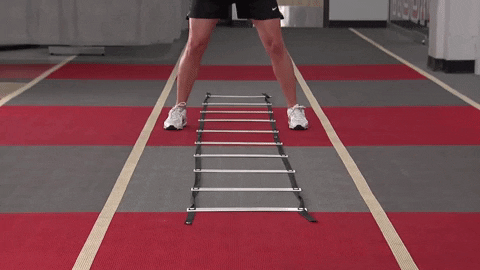
Skill Level: Intermediate & Advanced
Lateral Quick Steps
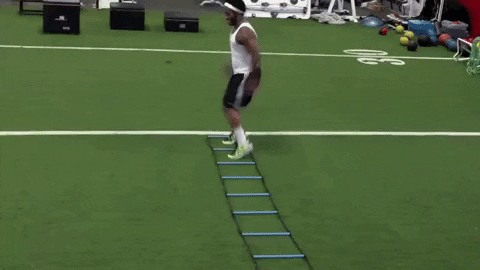
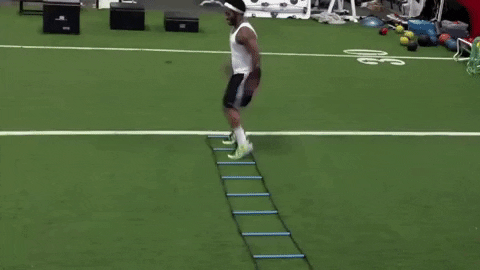
This is one of the most challenging quickness tennis drills because it consumes more energy and burns more calories. However, it also increases your endurance.
Skill Level: Intermediate & Advanced
Tennis Groundstroke Drills
Groundstroke is the heart and foundation of tennis that are taught to all level players. So, mastering this stroke is vital, especially for baseliners.
The groundstroke drills I am going to share can be modified with forehand or backhand according to your playing style.
After mastering groundstroke drills, learning rallying will be easy for you.
Single Service Box Rally
As the name suggests, you and your opponent are allowed to use only one service box to practice a long and consistent rally.
Note: No volleys are allowed in this drill.
Try to maintain a consistent rally by focusing on your body balance and foot movement.
In this drill, you can use forehand, backhand, slice, and other techniques to make your rally full of variety when hitting a stroke.
20 Balls
The purpose of this drill is to improve your consistency at groundstrokes. For this drill, you will need a partner to feed the balls.
Ask your partner to feed 10 balls in a row at your forehand and backhand. All you have to do is to hit those 10 balls cross-court without missing a single one.
Take 20-30 seconds of rest and then ask your partner to feed the remaining 10 balls.
Note: You will be standing near the baseline.
Hand Toss
This drill improves your movement and speed for groundstrokes. Ask your partner to feed the balls randomly so you have to move quickly across the court to return the balls.
This will keep you quick and active on your feet.
Tennis Attacking Drills
The purpose of all attacking drills is to pressurize and confuse your opponent so you can learn his/her weaknesses and later you can use them against your opponent.
This is the same technique that I have discussed in my article on tennis doubles strategies.
Attacking the net
When you quickly move up to the net, this puts tremendous pressure on your opponent unless he/she is aware of your tactic.
In this drill, you need a partner to play a practice match. Try different variations like serve and volley, return and volley or approach short balls.
Tennis Volley Drills
"V" Drill
For this drill, you need a partner to play a practice game. First of all, make a "V" shape on your side of the court using some tape or other material that can easily be removed after the practice.
The joining point of the V should be at the center of the net and the opening ends of the tape should be at both ends of the service line as shown in the picture below.
Crowded Volleys
This drill can be practiced only when you are practicing as a team with more than two players.
All players must stand in a straight vertical line facing the net. Use one player to provide the balls from the other side of the court.
When the first player from the line has returned a successful volley, he/she moves out of the line and the player next in the queue returns the volley until the queue of players is finished.
Dominant Hand Volley
In this volley drill, you will be using only your dominant hand without any interference from the non-dominant hand.
Put your non-dominant hand on your back and perform volleys using your dominant hand only.
The purpose of this drill is to prepare your dominant hand fully for the volleys. When you hit using the main hand only, it strengthens your dominant hand for harder volleys.
Ghost Doubles
In this drill, you need a partner and you can side only half of the court. It means if you are serving from deuce court, your partner must also be standing on deuce court on his/her side of the court.
This drill also stimulates doubles drill, that's why it's named ghost doubles where there are only two players (singles).
There are three steps of this drill.
First, you have to serve and move quickly to the net to return the volley. When the point is finished, you can change the courtside (ad or deuce) as we do in a normal tennis match.
Volley-To-Volley
As the name suggests, in this drill, you will be hitting volley to volley rather than free hitting. So, this hitting drill requires a partner.
This is one of the best tennis drills to improve your volleys in a shorter time.
Stand at the center of the service line while your partner stands at the center of the service line on his/her side of the court.
Hit the ball to your partner who is going to return the volley to you. You will also return the volley to your partner. This continues until any of the players misses the shot.
At first, it is a little tough to return volley after volley, when practiced regularly, mastering this drill will be easy and it will also prepare you for powerful volleys.
Mad Volleys
This drill is quite challenging if you are a beginner player and learning volleys or even improving your volleys, but trust me, this drill will take your volleys to the next level when practiced regularly.
In this drill, you need a partner to feed the balls.
Stand near the net, while your partner is standing in the mid-way of the baseline and service line on the other side of the court with a hopper holding 60-70 tennis balls.
Ask your partner to feed the ball one after the other and you have to perform the volleys after volleys. Make sure your partner feeds random shots (low, high, slow, fast, left, right, etc).
In this way, you can sharpen your volley skills more precisely.
Targeted Volley
This drill requires two players one being the ball feeder standing between the baseline and the service line.
The feeder must have a hopper with 20-30 balls to feed continuously. Before you start this drill, mark three zones on the baseline of the feeder's courtside, each zone 12 feet apart. You can use cones to mark the zones.
Before feeding, the feeder must say loudly "zone 1", "zone 2", or "zone 3" to set a target for you. You must return the volley to the zone targeted by your partner.
This drill is a great way to improve the precision of your volleys.
Tennis Lob Drills
Lob and Overhead
In lob and overhead drills, you will be standing at the center mark of the service line while your partner standing at the baseline on the other side of the court.
When your partner is going to hit the ball, you have to move quickly to the net and touch it with your racket.
In the meantime, your partner hits a lob and you have to practice backpedaling quick enough to return the lob and win a point.
This drill helps learn how to return the lob efficiently without losing a point.
Running Lobs
In this drill, you and your partner will both be standing at the baseline on the opposite sides of the court.
You have to feed the short ball to your partner so your partner comes closer to the net to return the ball.
When your partner is at the net, you will perform a lob over your partner.
This drill benefits both of you. You will be learning to perform a lob to dominate the depth of the court while your partner learns how to return a lob.
Targeted Lobs
Like targeted volleys, place small targets around the court while you are standing on the baseline and your partner at the net with the targets' side.
Feed your partner a ball and your partner returns the ball. After that, you will hit a lob at a target of your partner's choice.
This drill improves the placement and accuracy of your lobs.
Tennis Drills for Kids
Being a big fan of tennis, I would like my kid to be a tennis star in the future. I believe you have the same thoughts for your kids. In another case, you must be a tennis coach looking for a list of Kids Tennis Drills to train your students.
If this is right, then tennis training for junior students from a young age (if they aim to choose this field in the future) is a perfect time because, at this age, kids can quickly learn the fundamentals, techniques and build confidence for tennis.
I have shortlisted the following essential basic drills that work perfectly for my students.
Frying Pan
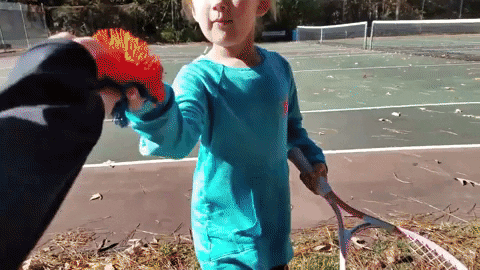
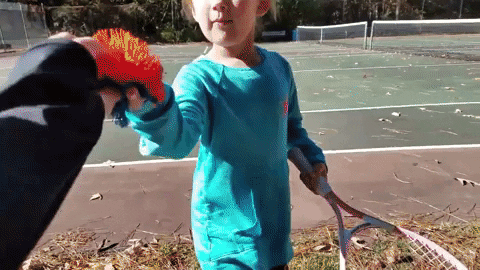
This is one of the very basic tennis drills for beginners and kids to give them a hands-on experience if they are complete newbies.
- Ask your students to pick up the racquet in the dominant hand with a continental grip. Just like we hold a frying pan. (If you are looking to pick beginner racquets for them, check my latest reviews on beginner tennis racquets). Or read my detailed gear reviews about top tennis racket brands.
- Place the tennis ball on the stringbed and ask them to bounce the ball for as long as they can do it. As they are beginners, if they miss the ball frequently, you must encourage them to practice it perfectly.
This drill not only builds their confidence but also improves eye-hand coordination at the beginner level.
Once they have mastered this drill, you can make it more challenging by asking them to rotate the racquet at 180 degrees between each ball bounce.
Shoe Box Drill
This is an interesting indoor tennis drill for kids and newbies. The purpose of this drill is to improve their movement and speed on the court.
Note: If you have multiple students to train, you have to call them one by one as this drill is taught individually.
Increase your throwing speed gradually to make their training challenging with time.
Count one point per catch and deduct one point if they miss the ball and declare the highest point winner, the winner of the day. In this way, you can keep them motivated.
Catch & Put
Again, you will be teaching this drill to one student at a time. We will use the same setup as before, i.e. you will be standing near the net with a hopper of tennis balls and the student stands at the center of the baseline on the other side of the court.
The only difference is that you have to put a basket near the student and the student holds a tennis racket.
- Start throwing the one ball at a time and ask the student to direct the ball to the basket with the help of the racket. Make sure the student hits the ball after it bounces once.
At the start, place the basket near the student and keep moving it away with the time to make the drill challenging.
To make this drill a little easy for new kids, ask your student to catch the ball with the help of the racquet's stringbed and run towards the basket to put the ball in it and return to the original position.
Through this drill, they will learn the precision and improve their speed.
Cone Catch
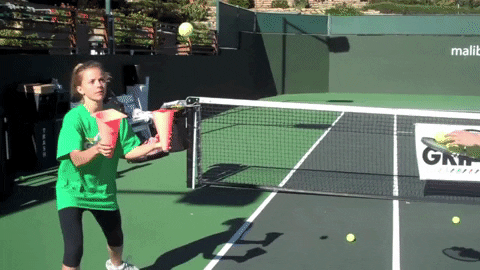
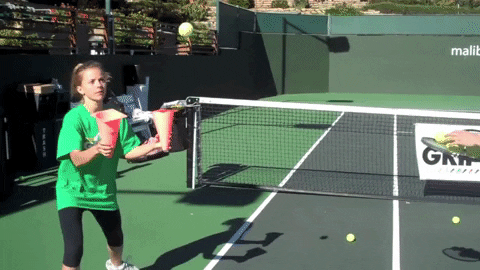
This drill is more exciting and full of fun. The purpose of this drill is to improve hand-eye coordination and concentration. We will use the same setup for the trainer and trainees.
The only difference is that the trainee will be holding a cone for this drill instead of a racquet. So, our main equipment for this drill is a tennis ball and a cone.
- Throw one ball at a time and the student has to catch the ball with the cone in such a way that it drops into the cone perfectly. Make sure the ball bounces once before the trainee catches it.
- The student has to move quickly towards the basket, put the ball in it, and return to the original position.
Again, declare the winner of the day to keep your students motivated.
Bouncing Balls
Another name of this drill is dribble because it is similar to the basketball's dribble. In this drill, you can train multiple students as a team, but I suggest 5 students per team and train one team at a time.
Before starting this drill, mark some areas near the net with cones or any other thing.
Any student who misses the ball should be eliminated from the round so you can declare the winner to keep them motivated.
Note: This drill can be performed anywhere without a court.
Catch & Toss - Forehand Drill
This is one of the best tennis drills to train your students with basic forehand techniques. Ask your student to stand near the net at the center of the service line by keeping his feet a little close enough so he can bend his knees.
You will be standing near the net with a basket of balls on the other side of the court.
Once the students are trained enough for this drill, ask them to use a racquet instead of bare hands.
Tennis Balance Drills
No matter if you are playing a forehand, backhand, or a quick volley, your body needs consistency and balance all the time so you can quickly react to every shot.
Why is balance important in tennis?
The main object we try to hit and control is the tennis ball. So, the main problem players, at all levels, face is controlling the ball.
We can't control the ball 100%, most of the time we are playing at probabilities due to unforced errors because of the environment and so many other things.
However, we can try to control the ball as far as we balance our bodies. So, the balance, stability, and control of the ball go hand in hand.
Jumping Spot to Spot
This balance and leg strengthening drill is for beginners players and kids. Below I have shared some balance exercises for advanced players as well.
As the name suggests, in this drill, the player will be jumping from spot to spot using one leg only. This drill not only improves balance but also strengthens your legs.
- Have 4-5 kids/students stand in a line behind each other on the left side of the court near the baseline.
- Mark the areas on the court starting from the feet of the first student and ending on the left pole of the net in such a way that these marked areas create a shape like a parabola as shown in the above picture.
- Ask the first kid in the line to stand on his right leg and jump to the marked area without touching the left leg to the ground.
- Once the kid has moved to the marked area, ask him to balance the body in the same position(standing straight) on one leg.
- Then ask this kid to keep jumping and balancing until he reaches the last marked area.
- Once the first kid has finished this drill, ask the second kid in the line to do the same until all kids have finished this drill.
To make this drill challenging, ask the student to alternate legs on each jump. You can also modify the pattern of the marked areas to make this exercise more difficult.
Rope Walk
Don't worry, we are not going to walk over a rope in the air.
Banded Toes
- Take a loop resistance band and put it in your legs just above your ankles.
- Stand straight with your feet joined together and holding your arms out wide to your sides.
- Engage your hip muscles.
- Move your right leg in the backward, right and forward direction.
- Keep doing this with the same leg as far as you can.
- When you are done with the right leg, repeat the same procedure with your left leg.
Weight Shifting
Standing Crunch with Raised Leg
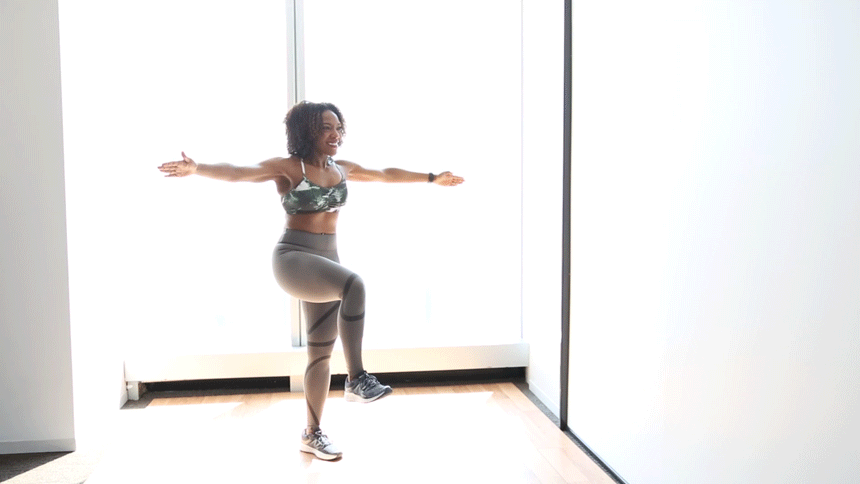
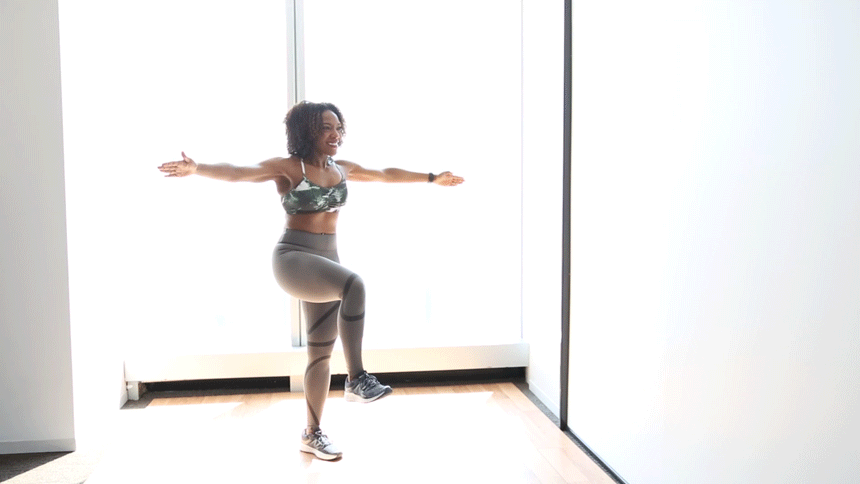
Big Arm Circles on Feet' Balls
Hand-Eye Coordination Drills
Balance and agility are two important aspects of a tennis game that we can't neglect. It's because, without balance, you can't move quickly on the court, and also you can't make a proper position to hit the ball.
Once you learn to maintain balance, it is easy to focus on hand-eye coordination drills because these drills work best with the center of gravity.
To improve balance, train your glutes, abs, lower back, and hips with different exercises.
You might be thinking, what is hand-eye coordination?
Hand-eye coordination means the ability of the body to get visual data from the eyes and then move the hands and react according to the visual information.
In tennis, hand-eye coordination is very important because you have to maintain your body position before hitting each shot.
Moreover, hand-eye coordination is important for shot precision so you can hit the ball and direct it on the court where you want it to be instead of letting your body struggle before hitting.
Generally, hand-eye coordination drills are done using tennis balls. Let's practice some of them.
Ball Catching
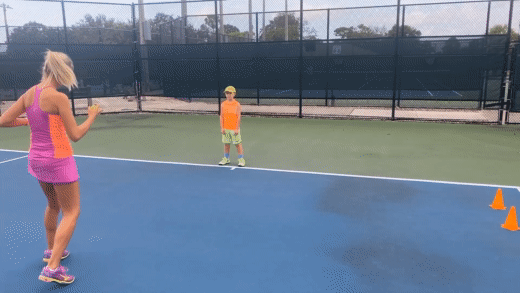
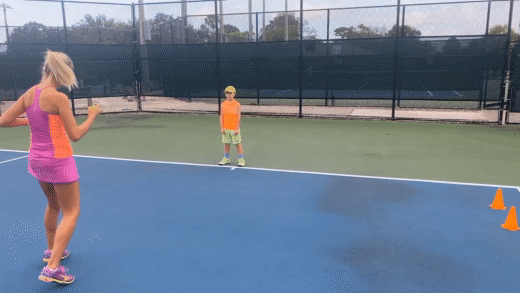
This is one of the most basic tennis drills to improve hand-eye coordination. You must have done this throughout your life without intentions. That must be at a young age.
If true, you need to train and improve your hand-eye coordination through this simple drill.
For this drill, you need a partner to throw balls at you one by one. All you have to do is to catch all those balls.
Make sure your partner throws the balls at different paces and directions.
We can make it more challenging. Write the number on each ball and call out the number loudly before catching it.
Or you can call and throw it back to the feeding player to make a smooth drill.
Reaction Balls Against a Wall
A reaction ball is a small rubber ball that is designed in such a way that it changes direction, spin, and bounces on each bounce which is a great thing to improve reaction time and ultimately hand-eye coordination.
Juggling
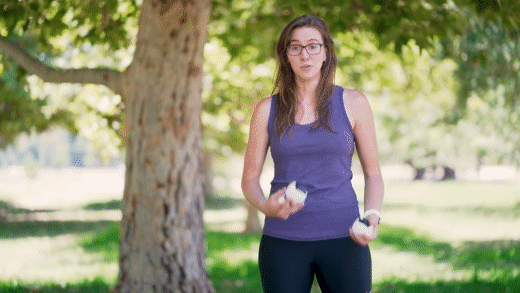
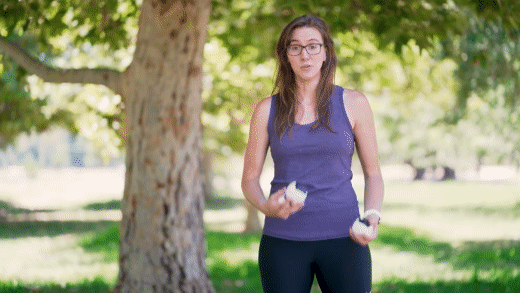
Although juggling is a little tough drill and takes a lot of time to master, this is one of the best tennis drills for hand-eye movement and coordination.
This drill improves the focus to a greater extent.
Tennis Cool Down

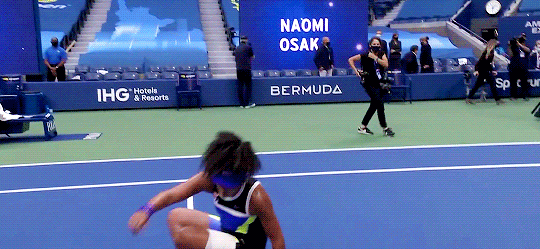
You did very well warm-up before starting tennis drills and performed great on the court. Now you must be tired after this vigorous activity.
What are you going to do next?
I guess right, you are going to just sit down, clean your sweat with a towel, and relax.
What if I tell you this is not the right thing to do after playing or doing tennis drills?
Yes exactly, mostly new and even tweener players fail to cool down in the right way. You must cool down your body gradually in the right way instead of cooling down abruptly.
"Cool Down" is a fancy term used for the phase of muscle recovery after hard work.
When you are smashing the balls on the court, your body is constantly fighting against the environment and working hard to prepare you for every shot.
When you are finished with your match or training, your body tries to return to the initial comfort state. This is where your body goes to a "shock" state because you are no longer doing hard work.
If you don't cool down your body gradually, it may result in different injuries like cramping, dizziness, muscle tightness, or joint pain. That's why your tennis strategy requires recovery drills as well.
Moreover, your body also tries to tighten up muscles in the recovery phase.
This is where you need to feed your body with proper nutrition, and stretching exercises to avoid the above-mentioned injuries.
Nutrition:- Keep a post-workout sports drink in your bag whenever you go for playing.
- Eat healthy carbohydrates and lean protein so that your body can start repairing damaged muscles.
- Drink at least 3-4 glasses of water within 2-3 hours after playing to keep your body hydrated so that it can recover the lost water.
- After finishing your training match, do some stretching exercises so that your muscles don't tighten up in the recovery phase.
Some stretching exercises that you can include in your routine are:
Movement:Once you are done with the stretching, do some movement drills to further improve the recovery process. For movement, you can include light jogging or bike riding.
Conclusion: Final words for our Tennis Drills
No matter if you are a beginner, intermediate, advanced tennis player, or a coach looking for tennis academy drills, the drills I have shared are equally helpful for all levels.
What distinguishes a tennis pro from other players, is the right set of skills, tactics, techniques, and playing style which is possible only when you have practiced a lot and following a proper tennis drills strategy.
So, here at SuperTennisRacquet, we strive our best to help all level tennis players and this article is one of those tips, techniques, and strategies that I learned in my 10 years of coaching experience.
I hope you would have learned a lot of new tactics and tennis drills to take your game to the next level. Don't forget to share this article with your tennis fellows, friends, and family who might also find it helpful.
Also don't forget to bookmark this guide, as I will be updating this article with more advanced drills from time to time.
Got any questions or want to share any special drills with us, do share them in the comments section below.
FAQs 1. What are tennis drills?Tennis drills are nothing but tactics and techniques to improve your game and playing style while sharpening your skills. For a beginner, these drills help to learn tennis fundamentals.
2. Can I practice tennis drills alone?Of course, here is the list of solo tennis drills you can perform by yourself easily. Read in detail above.
- All warm-up Drills
- Upper & Lower Body Exercises
- Stretching Exercises
- Footwork Drills excluding running the lines and spider run
- Ladder Drills
- Drills for kids
- Resistance Band Drills
Here is the list of drills for adults, read in detail above.
- Drop Shots
- No-bounce drills
- Cross-Court Point Play
- Figure Eight Volley
- Cardio Drills
- Warmup & Stretching
- Ball Machine Drills
There are two types of quickness in tennis. First fast on feet and fast on strokes. Feet quickness can be improved by various footwork drills like quick steps, high knees jump, and jumping jacks, etc.
5. Why is speed important in tennis?Speed and balance are vital factors in tennis. A tennis player's performance is measured by how fast he/she reacts to every stroke and how efficiently he/she hits the shot while keeping the whole body in ideal balance. When your body is in the right balance, you can direct the ball wherever you want on the court.
This is the reason, we pay full attention to improve speed, agility, and balance through various drills.
Was this article helpful?

